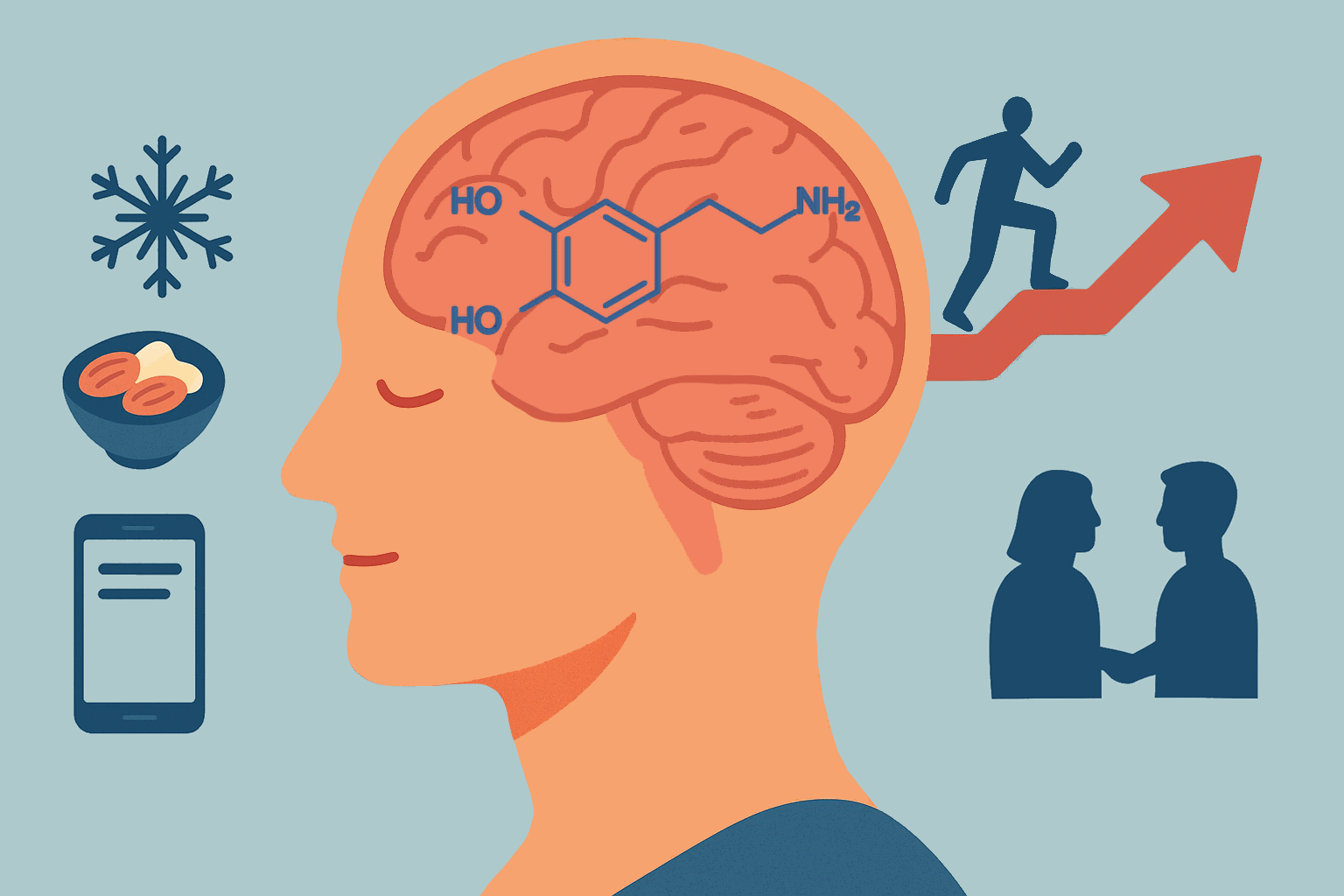
Harnessing Your Drive: Dopamine's Crucial Role in Motivation and Well-being
- Olivia Hart
- Health , Neuroscience , Lifestyle , Mental well being
- May 3, 2025
Table of Contents
Fast Facts: Understanding Dopamine (TL;DR)
- Dopamine is Key: More than pleasure, it drives motivation, movement, learning, and focus.
- Pathways Matter: Distinct brain circuits (mesocortical, nigrostriatal, mesolimbic) control different dopamine-dependent functions.
- Balance is Crucial: Chronic artificial highs can lower baseline dopamine, reducing natural enjoyment and drive.
- Tech Overload: Constant digital stimuli can create compulsive dopamine-seeking loops, impacting focus.
- Boost Naturally: Strategies like intermittent fasting, cold exposure, social connection, exercise, and mindful tech use support healthy dopamine levels.
- Parkinson’s Link: Degeneration of dopamine-producing neurons causes the motor symptoms of Parkinson’s disease.
The Driving Force Within: Understanding Dopamine’s Impact on Your Health Journey
Dopamine. You’ve likely encountered the term, often linked simplistically to pleasure. But this powerful brain chemical is far more nuanced and fundamental to our daily functioning and long-term health goals. Understanding how dopamine works – its cycles, its triggers, and how to cultivate a healthy balance – is a cornerstone of sustainable well-being, motivation, and a truly vibrant life. As we delve into the science of dopamine, we’ll uncover how it not only shapes our desires but also our ability to act on them, directly influencing your path to a healthier lifestyle.
Decoding Dopamine: Beyond Pleasure to Motivation, Movement, and Mind
Dopamine is a crucial neurotransmitter and neuromodulator within your nervous system [14]. As a neurotransmitter, it transmits signals between nerve cells (neurons). As a neuromodulator, it fine-tunes the activity of larger brain circuits, influencing how other neurotransmitters operate. While intrinsically linked to the brain’s reward system and feelings of pleasure, its role extends significantly further. Dopamine is fundamentally involved in:
- Motivation and Drive: It’s the neurochemical engine that fuels our desire to pursue goals, seek rewards, and engage in necessary activities. That “get-up-and-go” feeling or the “wanting” and “seeking” of a particular outcome is heavily dopamine-driven [2].
- Motor Control: Dopamine plays a vital part in initiating and controlling voluntary movement. Its precise regulation ensures smooth, coordinated physical actions.
- Learning and Memory: It reinforces behaviors by signaling which actions lead to positive outcomes (or help avoid negative ones), thus shaping our habits and learning processes [4]. This is key for forming healthy routines.
- Attention and Focus: Dopamine contributes to our ability to concentrate, filter distractions, and direct our attention towards salient information.
- Mood Regulation: While complex and involving multiple neurotransmitters, dopamine plays a role in mood, and dysregulation is implicated in conditions like depression [13].
The critical role of dopamine in movement is tragically illustrated in Parkinson’s disease. This neurodegenerative disorder involves the progressive loss of dopamine-producing neurons in a key brain region called the substantia nigra. This deficit directly causes the hallmark motor symptoms: tremors, rigidity, and slowed movement (bradykinesia) [3].
Neuroscientists map dopamine’s influence through distinct neural pathways, each with specialized functions:
- Mesocortical Pathway: Originating in the ventral tegmental area (VTA) and projecting to the prefrontal cortex, this pathway is essential for executive functions. These include higher-order cognitive processes like planning, working memory, decision-making, and sustained motivation. Dysregulation in this pathway is implicated in conditions like Attention-Deficit/Hyperactivity Disorder (ADHD) and aspects of addiction.
- Nigrostriatal Pathway: Connecting the substantia nigra to the striatum, this is the primary pathway controlling motor function and the initiation of movement. Its degradation is the central pathological feature of Parkinson’s disease [3].
- Mesolimbic Pathway: Also originating in the VTA but projecting to the nucleus accumbens and other limbic structures (like the amygdala and hippocampus), this is the renowned “reward pathway.” It drives feelings of pleasure, reinforcement learning, and assigns motivational significance to stimuli, compelling us to repeat rewarding experiences. It’s also a key pathway hijacked in addiction [1], [11].
Your Dopamine Dynamics: Baseline Levels and the Perils of Artificial Spikes
Every individual possesses a baseline level of dopamine activity, influenced significantly by genetics. However, this baseline is not static; our daily habits, lifestyle choices, environmental exposures, and even our thoughts constantly shape it.
Certain activities trigger a release of dopamine, experienced as pleasure, satisfaction, or motivation. The magnitude and duration of this release vary greatly:
Natural Rewards (Promoting Homeostasis):
- Food (especially palatable, energy-dense food like chocolate): Can increase dopamine levels roughly 1.5 to 2 times above baseline. This encourages us to seek sustenance.
- Sexual Activity: A potent natural reward, often doubling baseline dopamine levels, driving procreation.
- Exercise: Regular physical activity is known to boost dopamine and improve mood and focus.
- Achieving a Goal: Successfully completing a challenging task triggers a dopamine release, reinforcing productive behavior.
Artificial Stimulants (Disrupting Homeostasis):
- Nicotine: Causes a rapid spike, increasing dopamine by about 2.5 times baseline. Critically, this surge is fleeting and is typically followed by a sharp drop below the original baseline, powerfully contributing to cravings and the cycle of dependence [5].
- Illicit Drugs (e.g., amphetamines, cocaine): These substances hijack the dopamine system, causing an unnatural and intense flood – sometimes up to 10 times (or more for substances like methamphetamine) baseline levels. This overwhelming surge provides intense euphoria but can severely damage dopamine receptors and pathways. This can lead to long-term anhedonia (inability to feel pleasure from normal activities), profound lack of motivation, cognitive impairments, and severe addiction [12]. The potential for lasting neurological harm underscores the extreme danger of experimenting with these substances, even once.
The brain constantly seeks equilibrium, a state known as homeostasis. Chronic exposure to large, artificial dopamine spikes causes the brain to adapt defensively. It may reduce the number of dopamine receptors (downregulation) or decrease its natural dopamine production. This leads to tolerance (needing more of the substance or behavior for the same effect) and a lower overall baseline dopamine level, making everyday activities feel dull and unrewarding.
The Modern Dopamine Dilemma: Technology’s Constant, Seductive Pull
 In today’s hyper-connected world, technology, particularly smartphones and social media, acts as a potent, albeit often subtle, manipulator of our dopamine system. The constant barrage of notifications, the endless scroll of novel content on social media feeds, the variable reward schedules of games – these stimuli trigger frequent, small dopamine releases [6].
In today’s hyper-connected world, technology, particularly smartphones and social media, acts as a potent, albeit often subtle, manipulator of our dopamine system. The constant barrage of notifications, the endless scroll of novel content on social media feeds, the variable reward schedules of games – these stimuli trigger frequent, small dopamine releases [6].
This creates a cycle of seeking and reward that can easily become compulsive. The accessibility, immediacy, and unpredictable nature of these digital “hits” make them highly reinforcing. However, the dopamine dip that often follows putting the phone down or disengaging from these platforms can contribute to feelings of restlessness, anxiety, difficulty concentrating, or low motivation for tasks requiring sustained, non-digitally mediated effort. Over time, this pattern can potentially lower our baseline dopamine levels and impair our ability to find satisfaction and focus in less immediately gratifying, but often more meaningful, real-world activities and interactions. Understanding how to manage dopamine in the age of digital distraction is crucial for maintaining mental focus and well-being.
Cultivating Sustainable Dopamine Balance: Evidence-Based Strategies for a Healthier Lifestyle
Protecting and nurturing a healthy dopamine system is vital for sustained motivation, mental energy, and overall psychological well-being. This involves managing stimulation and adopting habits that support natural dopamine regulation, rather than constantly chasing artificial peaks. Consider these evidence-based approaches to enhance your dopamine levels naturally and sustainably:

Strategic Breaks & Resetting Dopamine Sensitivity (“Dopamine Fasting” Concepts): Continuously bombarding your reward pathways can lead to desensitization. Intentionally scheduling breaks from potent dopamine triggers (e.g., intense video gaming, constant social media checking, excessive consumption of highly palatable foods, or even back-to-back high-intensity entertainment) allows your system to reset. This concept is sometimes informally referred to as “dopamine fasting,” though it’s more accurately described as strategic desensitization. For instance, resisting the urge to engage in peak-level excitement every single day, even during leisure periods like vacations, can prevent the post-activity “crash” and help maintain a more stable mood and motivation level upon returning to routine. This can improve your ability to enjoy simpler pleasures.
Intermittent Fasting (IF) and Dopamine Regulation: Emerging research suggests that periods of dietary restriction, such as intermittent fasting, may positively influence dopamine pathways. By restricting eating to specific windows (e.g., following a 16/8 schedule, or occasional 24-hour fasts, depending on individual health and medical advice), you may enhance dopamine receptor sensitivity [7]. This could potentially increase the sense of reward and satisfaction derived from food when you do eat and may have broader neuroprotective effects. Always consult a healthcare professional before starting any new fasting regimen, especially if you have underlying health conditions.
Deliberate Cold Exposure for a Sustained Dopamine Boost: Practices like cold showers, ice baths, or brief cold-water immersion have been shown in some studies to cause a significant and sustained increase in baseline dopamine levels (and related catecholamines like norepinephrine), with effects potentially lasting for several hours post-exposure [8], [9]. This contrasts sharply with the short, often detrimental spikes from many artificial stimuli. The hormetic stress from cold exposure may trigger adaptive responses in the brain. We will explore the fascinating research behind cold exposure and its benefits in a future BioBrain post. Crucially, approach cold exposure gradually and safely. Start with cool water and shorten exposure times, slowly increasing intensity as your body adapts. Avoid extreme temperatures initially and never engage in risky behaviours like jumping into icy water without proper acclimatization, supervision, and safety measures. Consult your doctor if you have cardiovascular concerns.
Nurturing Social Connections and the Oxytocin-Dopamine Synergy: Meaningful human interaction is a powerful, natural modulator of our neurochemistry. Strong social bonds – encompassing familial love, romantic partnerships, and close friendships – promote the release of oxytocin, often dubbed the “bonding hormone.” Research indicates that oxytocin can work synergistically with dopamine, enhancing feelings of trust, well-being, and increasing the rewarding nature of positive social engagement. Prioritizing quality time, open communication, and supportive interactions with loved ones is a fundamental pillar for a healthy neurochemical balance and overall happiness.
Mindful Technology Use for Digital Wellness: Given the pervasive impact of digital devices, consciously managing screen time and interaction patterns is essential for healthy dopamine regulation. Implement strategies such as:
- Disabling non-essential notifications to reduce constant interruptions.
- Setting designated “tech-free” times (e.g., during meals, an hour before bed) or zones (e.g., the bedroom).
- Engaging with digital content intentionally (e.g., for a specific purpose) rather than passively scrolling.
- Using apps to track and limit time on certain platforms. These practices can help mitigate dopamine dysregulation, preserve focus for other life areas, and reduce the risk of digital addiction.
Other Foundational Pillars for Optimal Dopamine Function: Don’t underestimate the profound impact of these fundamental health practices:
- Regular Exercise: Physical activity, from brisk walking to resistance training, is a well-documented natural dopamine booster, also improving mood, sleep, and cognitive function.
- Adequate, Quality Sleep: Sleep is crucial for neuronal repair, memory consolidation, and neurotransmitter regulation, including the synthesis and balance of dopamine. Aim for 7-9 hours of quality sleep per night.
- Nutrient-Rich Diet: Consuming a balanced diet rich in tyrosine – an amino acid that is a precursor to dopamine – supports the body’s natural production pathways. Foods like lean proteins (chicken, turkey, fish), eggs, dairy, nuts, seeds, avocados, and legumes are good sources of tyrosine [10]. Also, ensure adequate intake of vitamins and minerals (like B vitamins, iron, magnesium) that act as cofactors in dopamine synthesis.
Conclusion: Taking Charge of Your Dopamine, Taking Charge of Your Drive and Well-being
Dopamine is far more than just the “pleasure molecule”; it’s the neurochemical current that powers our motivation, guides our movements, shapes our learning, and fundamentally influences our ability to engage with and enjoy the world. By understanding its intricate functions and respecting the importance of its balance – steering clear of excessive artificial spikes and actively cultivating habits that support its natural rhythms through mindful living, nutritious eating, strategic challenges like appropriately managed cold exposure, strong social connections, and consistent foundational health practices – we can proactively enhance our drive, energy, focus, and overall sense of well-being for the long term. Empower yourself with this knowledge to build a healthier, more motivated, and fulfilling life.
Frequently Asked Questions (Q&A)
Q1: What exactly is dopamine and what does it do?
Q2: How can I naturally increase my dopamine levels for better motivation?
Q3: Can too much dopamine be a bad thing?
Q4: How does technology affect my dopamine?
Q5: What is 'dopamine fasting' and does it work?
Disclaimer
The information provided on BioBrain is intended for educational purposes only and is grounded in science, common sense, and evidence-based medicine. It is not a substitute for professional medical advice, diagnosis, or treatment. Always consult a qualified healthcare provider before making significant changes to your diet, exercise routine, or overall health plan.
References
- Volkow, N. D., Wise, R. A., & Baler, R. (2017) "The Dopamine Motive System: Implications for Drug and Food Addiction"
- Baik, J. H. (2020) "Dopamine Signaling in Reward-Related Behaviors"
- Poewe, W., Seppi, K., Tanner, C. M., Halliday, G. M., Brundin, P., Volkmann, J., ... & Lang, A. E. (2017) "Parkinson disease"
- Pignatelli, M., & Bonci, A. (2015) "Role of Dopamine in Learning, Memory and Motivation"
- National Institute on Drug Abuse (NIDA) (2020) "The Science of Drug Use and Addiction: The Basics"
- Lustig, R. H. (2017) "The Hacking of the American Mind: The Science Behind the Corporate Takeover of Our Bodies and Brains"
- Mattson, M. P., Longo, V. D., & Harvie, M. (2017) "Impact of intermittent fasting on health and disease processes"
- Huttunen, P., Kokko, L., & Ylijukuri, V. (2004) "Winter-swimming improves general well-being"
- Šrámek, P., Šimečková, M., Janský, L., Šavlíková, J., & Vybíral, S. (2000) "Human physiological responses to immersion into water of different temperatures"
- Young, S. N. (2007) "L-Tyrosine to alleviate the effects of stress?"
- Bressan, R. A., & Crippa, J. A. (2005) "The role of dopamine in reward and pleasure behaviour–review of data from preclinical research"
- Weinschenk, Z. N., & važna, A. (2012) "The addicted brain: the role of dopamine in substance use disorders"
- Dunlop, B. W., & Nemeroff, C. B. (2007) "The role of dopamine in the pathophysiology of depression"
- Cleveland Clinic (2022) "Dopamine"
- Harvard Medical School (2020) "Dopamine: The pathway to pleasure"
Tags :
- Dopamine
- Motivation
- Neurotransmitter
- Brain health
- Healthy habits
- Intermittent fasting
- Cold therapy
- Social connection
- Digital wellness
- Reward system
- Parkinson's disease
- How to increase dopamine naturally
- Balancing dopamine levels
- Neuroscience of motivation
